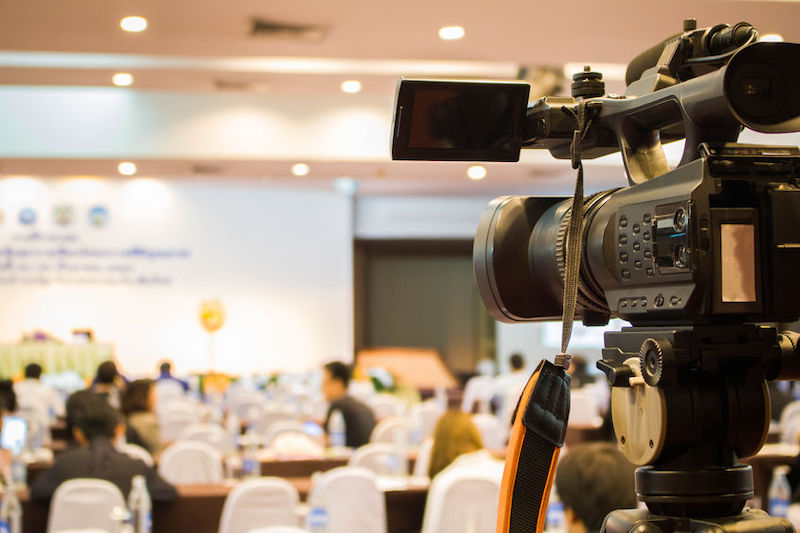Hybrid events are becoming increasingly important in a world changed forever by COVID, increased transport costs, and climate change awareness. Find out how to ensure your hybrid event is as successful as possible.
The events landscape changed massively with the advent of COVID, as it was impossible to gather large numbers of people in one space for more than a year. Thankfully, we have now returned to a situation that feels more normal. However, despite its passing, the pandemic and other significant world events continue to reshape our attitudes and habits.
Attending an event in person raises questions now that so many of us have accepted online meetings as normal practice. Therefore, the inconvenience, cost, and carbon footprint of traveling to an event have become more apparent. I’m not saying for a moment that in-person attendance at events has come to an end. Far from it. But events with the option to attend either in person or remotely are now more tempting than ever. Behold, the hybrid event has come of age!

Advantages of holding a hybrid event
Let’s imagine, for a moment, that a national organisation wants to deliver workforce training. Training sessions could be held at venues across the country, so everyone who needs the training can attend locally. Alternatively, the event could be held at a large central venue, to which everyone travels.
In the first scenario, there will be costs associated with delivering the training at multiple venues. These could include venue hire costs and instructor fees, for example. In the second scenario, those attending from a distance will, of course, create transport costs, which could be significant. In addition, hiring a large venue also has potential cost implications. It’s also likely that the commute will extend the working day of many attendees, which won’t be popular.
However, a third option would be to hold a hybrid event. Those living within easy reach of the live event can attend in person. Meanwhile, those who live further away can attend online. This offers cost savings to the organisation, either for venue hire and training fees or for workforce traveling expenses. In addition, those who live at a distance don’t need to start or end their working day any differently. Definitely a win-win scenario!
However, it’s not all silver lining and no cloud, as managing a hybrid event presents its own unique challenges.
What do I need to think about if I’m holding a hybrid event?
On paper, a hybrid event looks like a simple enough idea. Because in theory, all you need is a laptop or tablet and a broadband internet connection. In theory, with these tools, you can address an in-person audience while also streaming video from your device. In practice, however, there are many more considerations than the simple mechanics of being on-stage and online simultaneously. Oh, and by the way, I was joking about the laptop or tablet!
A game of two halves.
Hybrid events have to reach two distinct audiences. Each audience has different needs that you must satisfy. Each audience has different constraints on its behaviour during the event. And, if you’re not careful, each audience will have a very different quality of experience and a very different story to tell afterward.
When planning a hybrid event, you should be clear about what you’re trying to achieve in terms of objectives for both audiences.
Remember that a captive in-house audience has very different tolerances from one that can up and leave at will. Design your programme, accordingly, keeping individual presentations brief and focused.

Remote interaction
Make sure that you have a clear plan for interacting with your remote audience. To this end make sure that your presenters are very clear about delivering to and interacting with them. This should include briefing them about the position of cameras being used to capture the proceedings. Liaison between presenters and the technical crew is crucial. This is particularly important if there is anything unusual about a presenter’s delivery.
Managing Q&A across two audiences at your hybrid event is challenging. Having a dedicated moderator to handle incoming questions from remote attendees is highly recommended. You should also ensure that channels for submitting questions remotely are clearly signposted. Your procedures for passing remote questions to presenters should also be clear and well-rehearsed. In addition, presenters should be prompted, if necessary, to ensure the inclusion of remote questions.
Timekeeping
Don’t assume that remote attendees will sit throughout all timetabled presentations from start to finish. The very fact that they’re attending online might be because not every session is relevant to them. Give clear on-screen indications of when each presentation is about to commence rather than just an ‘ahem’ over the PA. You might even consider using text alerts or something similar. Be strict about timings, because remote attendees may have scheduled other activities around your published programme.
Keep them interested
It’s quite possible that some members of your online audience will tune in for long periods. With this in mind, give remote attendees something to occupy them during breaks and changeovers. This could be as simple as making relevant literature available to download. On the other hand, it could include relevant video material or slide presentations.
Establish an online group or social media hashtag for discussion during and following your event. Creating and maintaining a buzz around your hybrid event can add considerable value. Use the same channels to post highlights from your live stream or links to follow-up materials. Extend the life of your event well beyond the day on which it is held.

Choose the right facilities and the right people for your hybrid event
For a hybrid event, the online facility is just as important as the physical venue. With this in mind, check that your host venue has a good, stable internet connection. Make sure you have access to this via Ethernet, as hotel and conference venues are notorious for flaky Wi-Fi. It’s highly likely that the venue’s network is managed externally. If this is the case, ask the venue staff to supply contact details for their IT support.
Make sure that your technical personnel are in contact with the venue prior to the event, particularly IT support. Likewise, if your live streaming and event AV people are from different companies, make sure they talk to each other. The same thing goes if you’re using an in-house PA and projection system. Good communication can prevent the serious headache of discovering a technical issue on the day. Having said that, good techies should know their stuff and, like good Boy Scouts, are always prepared!
Learn more about how I can support your next virtual or hybrid event with my live production services.
Stourbridge-based Mooma Media offers event audio-visual support, event filming, live-streaming, video production, and still photography services to businesses, the public sector, and other non-commercial organisations throughout the Black Country and the wider West Midlands region. To discuss your project, or for a competitive quote click the button below.
Online broadcast/webcast support for virtual and hybrid events in and near:
West Midlands county: Birmingham, Solihull, Sutton Coldfield, West Bromwich, Dudley, Walsall, Wolverhampton.
Staffordshire: Lichfield, Tamworth, Stafford, Cannock,Burton upon Trent.
Shropshire: Telford, Shrewsbury, Bridgnorth, Kidderminster, Ludlow.
Worcestershire: Bromsgrove, Reditch, Droitwich, Worcester,
Warwickshire: Warwick, Stratford upon Avon, Leamington Spa, Coventry, Nuneaton,


Comments are closed